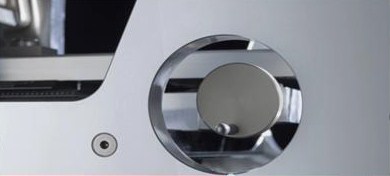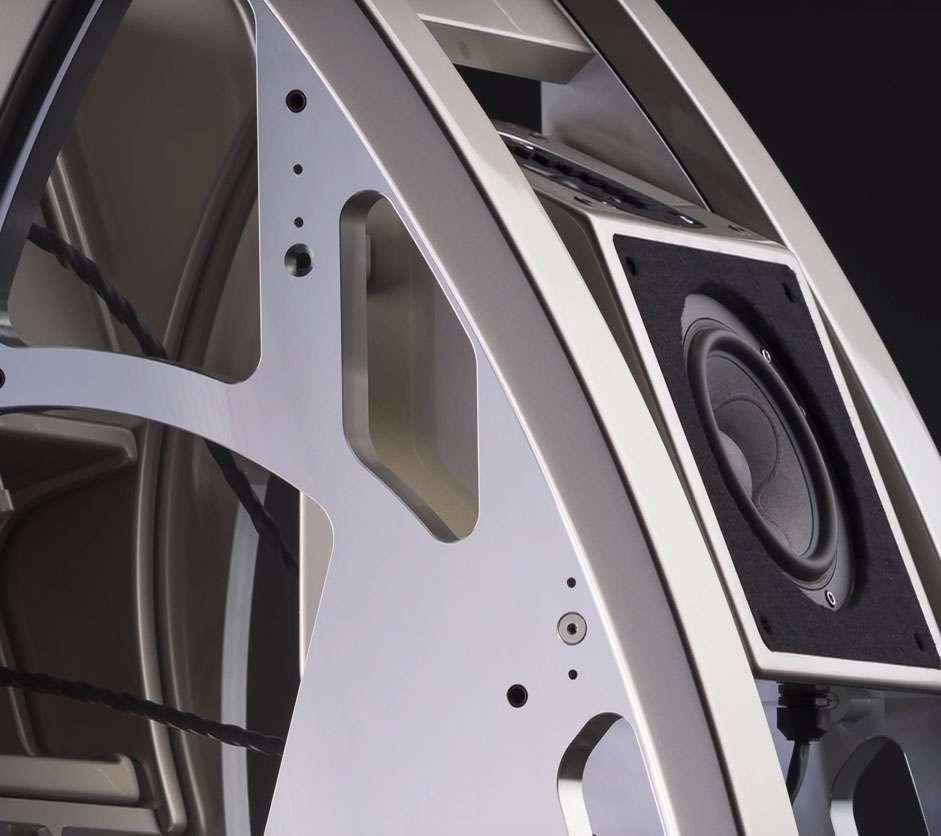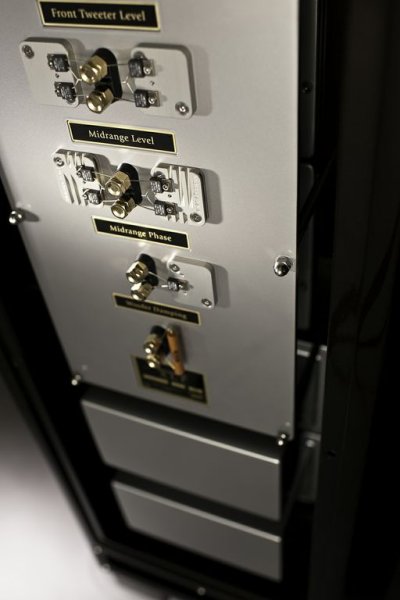New WAMM details
- Thread starter Adrian Low
- Start date
You are using an out of date browser. It may not display this or other websites correctly.
You should upgrade or use an alternative browser.
You should upgrade or use an alternative browser.
Come on guys, those bright colors are just too distracting from the music.
Unlike children, speakers should be heard, not seen. . . at least not very much.
Muted colors are the way to go.
Gary, about beautiful exotic wood from the Canadian West coast forests?
Updated Video:
They certainly picked the right music for the video. The fourth movement of the Saint-Saens Organ Symphony is great piece to show off a system's capabilities.
Make sure your artwork is firmly attached to your walls!
Daryl Wilson told a group at Definitive Audio in Seattle last night, that only 50 pairs of WAMMs will be made, plus one for David Wilson and one for road shows.
Daryl Wilson told a group at Definitive Audio in Seattle last night, that only 50 pairs of WAMMs will be made, plus one for David Wilson and one for road shows.
Hey Dan.... where you there? I didn't see you. Was certainly a great event last night. I was actually more impressed with the sound of the Yvette's.
Hey Dan.... where you there? I didn't see you. Was certainly a great event last night. I was actually more impressed with the sound of the Yvette's.
Bruce, you and I have never met, and I've never been to Seattle.
The info about Daryl Wilson's WAMM statement came from a post on another forum,
It looks like there's about 8 inches center to center from mid to tweeter. My guess is it crosses at about 1600hz. If it were above that it would lobe, unless the distance is less than it looks. It's a low frequency but some tweeters do it just fine.
There is no way he is crossing over from the mids to tweeters at 1600 Hz. If that is in writing than I will stand corrected. Those new mids implemented in his design have fantastic upper frequencies.
So then they have lobbing or my measurement ideas are way off magically? I based them on the size of the drivers.
Lobing is a very interesting thing in speaker design lol. I don't believe Dave's new speaker is designed as a near-field monitor. I can't wait to hopefully hear these some day
Last edited:
There is no way he is crossing over from the mids to tweeters at 1600 Hz. If that is in writing than I will stand corrected. Those new mids implemented in his design have fantastic upper frequencies.
Actually Leif, there are several reports that the mids of the XLFs are crossing into the tweeters considerably lower than they in the Alexandrias. Some estimate its about 1200 Hz whereas in the Alexandria Series 2, it was about 2500 Hz.
http://www.absolutesounds.com/pdf/main/press/HFNAlexXLF10124web.pdf
"One key issue here was the fact thatWilson’s 7in midrange driver, originally seen in the Series 2, can’t reach up to the 2.5-3kHz crossover frequency typically employed, presumably
because of cone breakup, and perhaps directivity, issues. Traditionally Wilson Audio doesn’t quote crossover points or slopes but it’s clear from its description of the new tweeter that it has to be able to operate down to around 1.2kHz, an octave or so lower. This in turn means that the Wilson tweeter has to have a low fundamental resonance frequency, something which militates against the use of low-mass dome materials, whose effect is to increase it."
This of course begs the question, why can't the Synergy Convergence tweeter in the XLF be retrofitted to the Alexandria Series 2? One can understand that the Alexandria 2 tweeter which crosses at 2.5K can't be used in the XLF, whose tweeters need to go down to 1.2K Hz. But I find it difficult to understand why the XLF tweeter can't be used in the Alexandria. After all, it only has to go down to 2.5K Hz, not 1.2 KHz. Hmmm.....
As to what is going on in the WAMM, I can't say. But if it is like the XLF, that tweeter is crossing in the 1.2 KHz area.
Marty
Actually Leif, there are several reports that the mids of the XLFs are crossing into the tweeters considerably lower than they in the Alexandrias. Some estimate its about 1200 Hz whereas in the Alexandria Series 2, it was about 2500 Hz.
http://www.absolutesounds.com/pdf/main/press/HFNAlexXLF10124web.pdf
"One key issue here was the fact thatWilson’s 7in midrange driver, originally seen in the Series 2, can’t reach up to the 2.5-3kHz crossover frequency typically employed, presumably
because of cone breakup, and perhaps directivity, issues. Traditionally Wilson Audio doesn’t quote crossover points or slopes but it’s clear from its description of the new tweeter that it has to be able to operate down to around 1.2kHz, an octave or so lower. This in turn means that the Wilson tweeter has to have a low fundamental resonance frequency, something which militates against the use of low-mass dome materials, whose effect is to increase it."
This of course begs the question, why can't the Synergy Convergence tweeter in the XLF be retrofitted to the Alexandria Series 2? One can understand that the Alexandria 2 tweeter which crosses at 2.5K can't be used in the XLF, whose tweeters need to go down to 1.2K Hz. But I find it difficult to understand why the XLF tweeter can't be used in the Alexandria. After all, it only has to go down to 2.5K Hz, not 1.2 KHz. Hmmm.....
As to what is going on in the WAMM, I can't say. But if it is like the XLF, that tweeter is crossing in the 1.2 KHz area.
Marty
While Wilson usually likes to run their tweeters as low as possible (crossover point ), I believe with dual 7" mid bass drivers and than dual 4" midrange drivers, the cross over points will be around 150/200 for the 7's and around 1k to 1.2k for the dual 4's, and than running the 4's up to 2500 or so. The 4 inch ScanSpeak Illuminater drivers are very comfortable up to 2500.
Cheers
Actually Leif, there are several reports that the mids of the XLFs are crossing into the tweeters considerably lower than they in the Alexandrias. Some estimate its about 1200 Hz whereas in the Alexandria Series 2, it was about 2500 Hz.
http://www.absolutesounds.com/pdf/main/press/HFNAlexXLF10124web.pdf
"One key issue here was the fact thatWilson’s 7in midrange driver, originally seen in the Series 2, can’t reach up to the 2.5-3kHz crossover frequency typically employed, presumably
because of cone breakup, and perhaps directivity, issues. Traditionally Wilson Audio doesn’t quote crossover points or slopes but it’s clear from its description of the new tweeter that it has to be able to operate down to around 1.2kHz, an octave or so lower. This in turn means that the Wilson tweeter has to have a low fundamental resonance frequency, something which militates against the use of low-mass dome materials, whose effect is to increase it."
This of course begs the question, why can't the Synergy Convergence tweeter in the XLF be retrofitted to the Alexandria Series 2? One can understand that the Alexandria 2 tweeter which crosses at 2.5K can't be used in the XLF, whose tweeters need to go down to 1.2K Hz. But I find it difficult to understand why the XLF tweeter can't be used in the Alexandria. After all, it only has to go down to 2.5K Hz, not 1.2 KHz. Hmmm.....
As to what is going on in the WAMM, I can't say. But if it is like the XLF, that tweeter is crossing in the 1.2 KHz area.
Marty
I wish it was that simple to just swap tweeters lol. Unfortunately it is a little more complicated than that. Did you get your speakers yet? I will be visiting Steve again shortly and it will be nice to listen to his system again
I was looking at the link you posted and if you scroll down to the lab report and look at the frequency response curve, you can see clearly where the midranges and tweeter are crossed over at. Now I will say there could be other reasons for that dip in the response at 2k, but since I didn't design the speaker or measure it I will never really know. But from the curve it appears that the crossover point between the mid and tweeter has a little spread to it. But we never really know unless the designer himself decides to share more precise information on his design. Voicing is a wonderful thing lol. I do know that I was extremely impressed with Steve's system though and I can't wait to hear Dave's new flagship
There is no way he is crossing over from the mids to tweeters at 1600 Hz. If that is in writing than I will stand corrected. Those new mids implemented in his design have fantastic upper frequencies.
I have read many inconclusive debates about the Alexandria XLF tweeter crossover points. Curiously the solution would be very simple - as the serial resistors used for level adjustment are easily accessible at the back of the speaker they can be easily electrically measured ... If someone sends me a pair of XLFs and I will happily do it - phase included!
Attachments
While Wilson usually likes to run their tweeters as low as possible (crossover point ), I believe with dual 7" mid bass drivers and than dual 4" midrange drivers, the cross over points will be around 150/200 for the 7's and around 1k to 1.2k for the dual 4's, and than running the 4's up to 2500 or so. The 4 inch ScanSpeak Illuminater drivers are very comfortable up to 2500.
Cheers
I agree. Having 4"s will typically allow for a higher tweeter XO point so the aspect of how low a tweeter can go is rather moot. I grew up listening to dome mids on ReVox and Isophon (now Gauder I believe) speakers and I had my own much later with Energy Veritas' flagship which unfortunately had problems with the woofers.
i agree with the above (mr jazz /jack ) , only down side"" of the illumator mids imo is that they re of limited eff 90 db for the highest out put one , they make 3 versions , its not low off course but there are 92 db units on the market allowing for lifting total speaker eff level even higher and giving amps an easier load , it also matters how they are filtered off course X over type used
I suppose its possible to have a model made under own specs if you buy in a large enough number .
To me its also price , neodymium magnet driven units like the scanspeak illuminator units are quit more pricey then ferrite ones , they are also paper composite and they come cheaper and at least as good
To my ears there is no benefit to use neodymium except for the tweeter in which the illuminator is the best regardless off price be it it a 10 000 $ diamond accuton or whatever.
as said before the tiny mid takes part of the audioband away from the tweeter in this model.
Are there bass towers with this model ?
havent seen a pic yet
Ps thats also the reason IMO why the Rockport arrakis was such a tough load earlier as those audiotechnology units were of very low eff, as seen on pics it seems rockport now uses the illuminator scanspeak drivesystem with their own design carbon fibre ? membrane
PS There is a tendancy among some audiophiles and magazines to discredit LS manufacturers who dont make the units themself , well i rather have a specialist do what he does best , in some cases i think its just a simple rebrand off course .
Only exception is the magico mid which is in imo, one of the best on the market
I suppose its possible to have a model made under own specs if you buy in a large enough number .
To me its also price , neodymium magnet driven units like the scanspeak illuminator units are quit more pricey then ferrite ones , they are also paper composite and they come cheaper and at least as good
To my ears there is no benefit to use neodymium except for the tweeter in which the illuminator is the best regardless off price be it it a 10 000 $ diamond accuton or whatever.
as said before the tiny mid takes part of the audioband away from the tweeter in this model.
Are there bass towers with this model ?
havent seen a pic yet
Ps thats also the reason IMO why the Rockport arrakis was such a tough load earlier as those audiotechnology units were of very low eff, as seen on pics it seems rockport now uses the illuminator scanspeak drivesystem with their own design carbon fibre ? membrane
PS There is a tendancy among some audiophiles and magazines to discredit LS manufacturers who dont make the units themself , well i rather have a specialist do what he does best , in some cases i think its just a simple rebrand off course .
Only exception is the magico mid which is in imo, one of the best on the market
Last edited:
Similar threads
- Replies
- 12
- Views
- 643
- Replies
- 2
- Views
- 503
- Replies
- 7
- Views
- 1K
- Replies
- 6
- Views
- 648
| Steve Williams Site Founder | Site Owner | Administrator | Ron Resnick Site Owner | Administrator | Julian (The Fixer) Website Build | Marketing Managersing |




